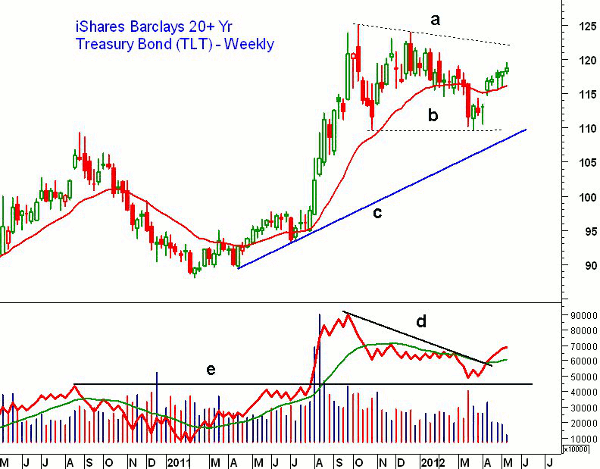A telling recent signal from a trusted bond market indicator as well as price action in a popular bond ETF suggests that stocks are likely to remain under pressure in the short term.
Global stocks have been under pressure for the past five days, but so far, the early selling in the US stock market has been well absorbed, as stocks have closed each day this week well above the early lows.
Most of the major averages made their highs in early April, and one measure of the interest rate market turned up just as stocks were topping. Commodities expert and bond market veteran John Person called my attention to the recent action of the NOB spread, which measures the difference, or spread, between T-bonds and T-notes.
When the economy is perceived as weakening or stocks are considered vulnerable, traders will often buy bonds and sell notes to take advantage of the difference in yields because long-term rates will typically fall faster than short-term rates.
As John noted, “The spread diverged from the stock market as the Sypder Trust (SPY) was making its high in early April, and as long as this spread continues to rise, it indicates that stocks are likely to be under pressure.”
The recent analysis of this spread will convince many stock investors to start following it on a regular basis. The analysis of long-term yields and a popular bond ETF can also be used to monitor the market’s perception of the economy.
Chart Analysis: The daily chart of the T-bond/T-note spread (left panel) shows that late last July, the spread broke through resistance and began a strong uptrend, line a.
- The uptrend in the spread corresponded to a downtrend in SPY, line b, which lasted until early October (line 1)
- Sharp new lows in SPY on October 4 did not correspond to a significant new high in the spread
- The spread moved sideways late in 2011 and by early 2012 had started a new downtrend
- The spread made its low on March 20 and then as SPY was making its high on April 2 at $142.21, the spread made a higher low, line e
- This divergence was confirmed when the downtrend in the spread, line d, was broken on April 20
- The spread has now reached first resistance and could move another two points, or 20%, higher
- SPY has now reached further support in the $135 area
The daily chart of T-bond yields (right panel) shows that they have been in a broad trading range, lines g and i, since last September. After the early-March rally, the improvement in some of the weekly momentum indicators suggested to me that yields may have finally bottomed.
- By April 20, the drop in yields suggested that I was wrong and yields had not bottomed, which caused me to comment, “The yield chart is looking more like it is forming a continuation pattern”
- Yields dropped below further support at 3.058%, line h, last week. This suggests that yields may test long-term support, line i, in the 2.867% area
- A strong close in yields below this support would project a drop to the 2.20%-2.30% range, which would imply a very weak economy
NEXT: Latest Technical Action in Popular Bond ETF
|pagebreak|The weekly chart of the iShares Barclays 20+ Year Treasury Bond Fund (TLT) shows the same trading range as the yield chart, but it does appear to be a bull flag formation, lines a and b.
- There is next resistance at $120.90-$121.60 with the weekly downtrend (line a) now at $122.20
- Completion of the flag formation has a 127.2% Fibonacci retracement target at $129.20 with further targets at $132-$134
- Weekly on-balance volume (OBV) dropped down to test stronger support in March, line e, but was then able to move back above its weighted moving average (WMA) in mid-April
- The downtrend in the OBV has also been broken, but the OBV is still well below last September’s high
- There is now minor support for TLT at $117.50-$118.10 with further support at $116.60
- TLT has been holdings its 20-week exponential moving average (EMA), which currently is at $115.86, for the past month
- The major 38.2% support from the early-2011 lows at $111 was broken in March before TLT turned higher
What It Means: The uptrend in the NOB spread and the positive action of TLT suggests that the correction in the stock market is likely to go further.
Stock index futures were again sharply lower prior to the US opening, and if they are able to close well above the early lows, it would increase the odds of an oversold rally.
TLT already looks overextended on a short-term basis and is likely to be higher again early today. I would look to buy TLT only if we get a correction back to support.
How to Profit: For the iShares Barclays 20+ Year Treasury Bond Fund (TLT), go 50% long at $118.06 and 50% long at $117.44 with a stop at $114.28 (risk of approx. 2.9%).




















